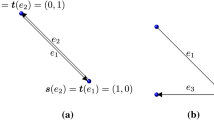Abstract
The enumeration theory is extended in this work into a more general theory, taking back-reactions into consideration. The solutions may faithfully reproduce real processes from arbitrary starting points to a steady-state. Therefore, the presented theory includes the equilibrium theory by Jacobson-Stockmayer, the numerical solution by Gordon-Temple, and the irreversible theory by the present authors. The solutions are described first in general forms of transition probabilities {P}, and then explicitly with the aid of rate equations; simple proofs are given. The presented theory was applied to an experimental data: the distribution of cyclic species in poly(ethylene terephthalate). We shall show that agreement between theory and experiment is nearly perfect.
Similar content being viewed by others
Abbreviations
- N 0 :
-
Total number of units
- V :
-
System volume
- C 0=N 0/N A ·V :
-
Initial concentration (N A : Avogadro's number)
- L x :
-
AB type chain x-mer; (AB)x
- N x :
-
Number of AB type x-mers
- R x :
-
Ring x-mer
- N Rx :
-
Number of ring x-mers
- E :
-
Small molecule eliminated by bond-formation
- N E :
-
Number of small molecules eliminated by bond-formation
- h k :
-
Number of reacted functional units (f.u.) in statek
- ξ k :
-
Number of reacted functional units (f.u.) in chains in statek
- Ξ k :
-
Total number of units in chains in statek
- D=h k /N 0 :
-
Extent of reaction in statek
- D *=ξ k /Ξ k :
-
Extent of reaction in chains in statek
- k L :
-
Chain-propagation rate constant
- k Rx :
-
Cyclization rate constant of chain x-mers
- k B :
-
Bond breakage rate constant of chains
- k B,Rx :
-
Bond breakage rate constant of cyclic x-mers
- <k Rx > k :
-
Mean cyclization rate constant in statek
- g(x)=k B,Rx /k B :
-
Ring-opening factor of cyclic x-mers
- P Lx,k :
-
Probability that a chain x-mer will be formed in statek
- {P}:
-
Set of transition probabilities per single jump in forward direction or reverse direction (see the text on individual transition probabilities)
- M A :
-
Total AA monomer unit number
- M B :
-
Total BB monomer unit number
- M 0=M A +M B :
-
Total particle number
- ζ A,i =2M A −h i :
-
Unreacted A functional unit (f.u.) number in statei
- ζ B,i =2M B −h i :
-
Unreacted B f.u. number in statei
- ζ Ax :
-
Unreacted A f.u. number on x-mers
- h i :
-
Number of reacted A (or B) f.u. in statei
- ξ i :
-
Number of reacted A (or B) f.u. in chains in statei
- Ξ A,i =2M A −h i +ξ i :
-
A f.u. number in chains in statei
- Ξ B,i =2M B −h i +ξ i :
-
B f.u. number in chains in statei
- Ξ i =2(M 0−h i +ξ i ):
-
Total f.u. number in chains in statei
- D=h i /M 0 :
-
Extent of reaction in statei
- D * A =ξ i /Ξ A,i :
-
Extent of reaction of A f.u. in chains in statei
- D * B =ξ i /Ξ B,i :
-
Extent of reaction of B f.u. in chains in statei
- D *=2ξ i /Ξ i :
-
Extent of reaction in chains in statei
- L αx :
-
(AA-BB)x-1-AA type chain x-mer;x=1,2,3,...
- L βx :
-
BB-(AA-BB)x type chain x-mer;x=0,1,2,...
- L γx :
-
(AA-BB)x type chain x-mer;x=1,2,3,...
- N αx :
-
Number of α type x-mers
- N βx :
-
Number of β type x-mers
- N γx :
-
Number of γ type x-mers
References
Kuhn W (1934) Kolloid Z 68:2
Jacobson H, Stockmayer WH (1950) J Chem Phys 18:1600
Jacobson H, Beckmann CO, Stockmayer WH (1950) J Chem Phys 18:1607
Flory PJ, Semlyen JA (1966) J Am Chem Soc 3209:88
Harris FE (1955) J Chem Phys 23:1518
Kilb RW (1958) J Phys Chem 969:62
Ahmad Z, Stepto RFT (1980) Colloid & Polymer Sci 258:663
Gordon M, Scantlebury GR (1966) Proc Roy Soc (London) A292:380
Spouge JL (1986) J Stat Phys 43:143
Gordon M, Roe R-J (1956) J Polym sci 21:75
Gordon M, Scantlebury GR (1968) J Polym Sci Part C No 16:3933
Gordon M, Temple WB (1972) Makromol Chem 152:277 Makromol Chem 1972 160:263
Temple WB (1972) Makromol Chem 160:277
Rolando RJ, Macosko CW (1987) Macromolecules 20:2707
Suematsu K, Okamoto T, “Theory of Ring Formation in Irreversible AB System”, see the preceding paper
Yuan X, Masters AJ, Nicholas CV, Booth C (1988) Makromol Chem 189:823
Simha R (1941) J Applied Phys 12:569
Cooper DR, Semlyen JA (1973) Polymer 14:185
Suter UW, Mutter M (1979) Makromol Chem 180:1761
For example, see Ogata N (1971) “Polycondensation”, p-92, Tokyo Kagaku Doujin, etc.
Hermans JJ (1965) Makromol Chem 87:21
Flory PJ (1986) “Principles of Polymer Chemistry”, Cornell University Press, Ithaca and London
Author information
Authors and Affiliations
Rights and permissions
About this article
Cite this article
Suematsu, K., Okamoto, T. Theory of ring formation in a reversible system: general solutions. Colloid Polym Sci 270, 405–420 (1992). https://doi.org/10.1007/BF00665983
Received:
Issue Date:
DOI: https://doi.org/10.1007/BF00665983




